
The Four Garrisons of Anxi were Chinese military garrisons installed by the Tang dynasty between 648 and 658. They were stationed at the Indo-European city-states of Qiuci (Kucha), Yutian (Hotan), Shule (Kashgar) and Yanqi (Karashahr). The Protectorate General to Pacify the West was headquartered in Qiuci.
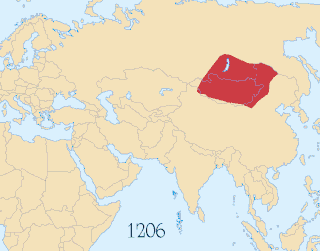
This is the timeline of the Mongol Empire from the birth of Temüjin, later Genghis Khan, to the ascension of Kublai Khan as emperor of the Yuan dynasty in 1271, though the title of Khagan continued to be used by the Yuan rulers into the Northern Yuan dynasty, a far less powerful successor entity, until 1634.

This is a timeline of the Tang dynasty, which covers a period of roughly 289 years, from 618, when the dynasty was founded, to 907, when the last Tang emperor was deposed by the warlord Zhu Wen, who established the Later Liang dynasty, inaugurating the period of Five Dynasties and Ten Kingdoms. Information on areas and events relevant to the Tang dynasty such as the Wu interregnum, when Wu Zetian established her own Zhou dynasty, and other realms such as the Sui dynasty, Tibetan Empire, Three Kingdoms of Korea, Nanzhao, Japan and steppe nomads are also included where necessary.
The siege of Lüshun was a military conflict between the Later Jin and Ming dynasty. In the summer of 1634 the Jin attacked and conquered the port city of Lüshun from Ming.
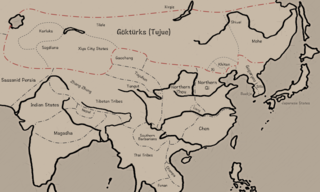
This is a timeline of the Göktürks from the origins of the Turkic Khaganate to the end of the Second Turkic Khaganate.
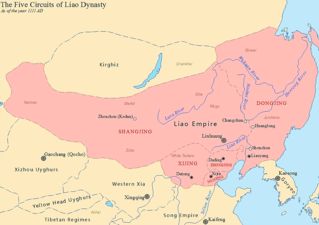
This is a timeline of the history of the Khitans. The Khitans were a nomadic people in northeastern Asia related to the Xianbei. Following the collapse of the Tang dynasty, they established the Liao dynasty in 916, encompassing parts of modern-day northern China, Mongolia, and North Korea. The Liao dynasty was eventually conquered by the Jin dynasty in 1125. Remnants of the Liao court led by Yelü Dashi fled westward to Central Asia where they established the Western Liao dynasty. In 1211, the Western Liao throne was usurped by a Naiman called Kuchlug. In 1218, the Mongol Empire defeated and conquered the Western Liao dynasty.
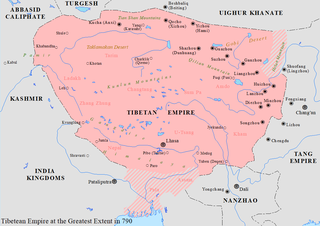
This is a timeline of the Tibetan Empire from 6th to 9th century.

This is a timeline of the Karluks. The Kara-Khanid Khanate is also included; however, it is disputed whether the Karluks or Yagmas were the dominant group within the khanate.

This is a timeline of the Jurchens.
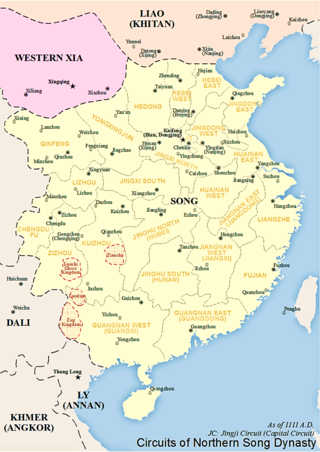
This is a timeline of the Song dynasty (960–1279). The Song dynasty was founded by Zhao Kuangyin, posthumously known as Emperor Taizu of Song, who ended the period of division known as the Five Dynasties and Ten Kingdoms period. The Song dynasty is commonly separated into two historical periods, the Northern Song (960–1127) and the Southern Song (1127–1279), divided by the loss of the north to the Jurchen Jin dynasty (1115–1234). In 1279, the Mongol Yuan dynasty conquered the Song.

This is a timeline of the Five Dynasties and Ten Kingdoms (907–979), which followed the collapse of the Tang dynasty in 907 AD. The Five Dynasties refer to the succession of dynasties which ruled northern China following the Tang collapse while the Ten Kingdoms, with the exception of Northern Han, ruled in southern China. This era of division ended in 979 AD with the rise of the Song dynasty under Emperor Taizu of Song, although the Song would never reconquer the northern territory lost to the Khitans, collectively known as the Sixteen Prefectures.

This is a timeline of Mongols prior to the Mongol Empire.
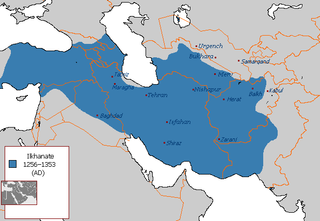
This is a timeline of the Ilkhanate.

This is a timeline of the Chagatai Khanate (1226–1348) and its successor states, Moghulistan (1347–1462), Yarkent Khanate (1514–1696), and the Turpan Khanate (1462–1680).
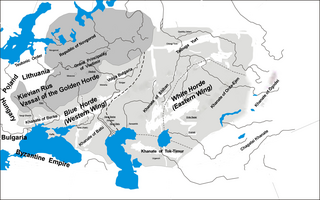
This is a timeline of events involving the Golden Horde (1242–1502), from 1459 also known as the Great Horde.

Yunnan under Ming rule saw the continuation of the tusi system instituted during the Yuan dynasty, increasing centralization, and Han migration into Yunnan.

This is a timeline of the Qing dynasty (1636–1912).

The Jurchen unification were a series of events in the late 16th and early 17th centuries that led to the unification of the Jurchen tribes under Nurhaci, a Jianzhou Jurchen leader who had an antagonistic relationship with the Ming dynasty due to their involvement in events early on in his life that led to the death of his father and grandfather. From 1583 to the early 1600s, Nurhaci led a series of military and influence campaigns that led to the unification of the majority of the Jurchen tribes. In 1616, Nurhaci established the Later Jin dynasty and ruled as its founding khan.

This is a timeline of the Xinjiang under the rule of the Qing dynasty.

This is a timeline of the Era of Fragmentation, the period of Tibetan history lasting from the death of the Tibetan Empire's last emperor, Langdarma, in 842 until Drogön Chögyal Phagpa gained control over the three provinces of Tibet in 1253 under Mongol rule.



















